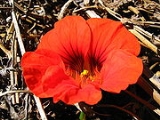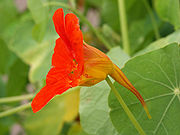
Tropaeolum majus
Encyclopedia
Tropaeolum majus is a flowering plant
in the family Tropaeolaceae, originating in South America
in the Andes
from Bolivia
north to Colombia
. It is of cultivated, probably hybrid origin, with possible parent species including T. minus, T. moritzianum, T. peltophorum, and T. peregrinum
.
 It is a herbaceous
It is a herbaceous
annual plant
with trailing stems growing to 1 m long or more. The leaves
are large, nearly circular, 3-15 cm diameter, green to glaucous green above, paler below; they are peltate
, with the 5-30 cm long petiole
near the middle of the leaf, with several veins radiating to the smoothly rounded or slightly lobed margin. The flower
s are 2.5–6 cm diameter, with five petals, eight stamens, and a 2.5–3 cm long nectar spur at the rear; they vary from yellow to orange to red, frilled and often darker at the base of the petals. The fruit
is 2 cm broad, three-segmented, each segment with a single large seed 1–1.5 cm long.
and as a medicinal plant.
Garden Nasturtiums are grown for their flowers, and also because both their leaves and flowers are edible; they can be used in salads, imparting a delicately peppery taste. The seeds are also edible, and can be used as a caper
substitute.
It is listed as invasive in several areas, including Hawaii
, Lord Howe Island
, and New Zealand
.
Flowering plant
The flowering plants , also known as Angiospermae or Magnoliophyta, are the most diverse group of land plants. Angiosperms are seed-producing plants like the gymnosperms and can be distinguished from the gymnosperms by a series of synapomorphies...
in the family Tropaeolaceae, originating in South America
South America
South America is a continent situated in the Western Hemisphere, mostly in the Southern Hemisphere, with a relatively small portion in the Northern Hemisphere. The continent is also considered a subcontinent of the Americas. It is bordered on the west by the Pacific Ocean and on the north and east...
in the Andes
Andes
The Andes is the world's longest continental mountain range. It is a continual range of highlands along the western coast of South America. This range is about long, about to wide , and of an average height of about .Along its length, the Andes is split into several ranges, which are separated...
from Bolivia
Bolivia
Bolivia officially known as Plurinational State of Bolivia , is a landlocked country in central South America. It is the poorest country in South America...
north to Colombia
Colombia
Colombia, officially the Republic of Colombia , is a unitary constitutional republic comprising thirty-two departments. The country is located in northwestern South America, bordered to the east by Venezuela and Brazil; to the south by Ecuador and Peru; to the north by the Caribbean Sea; to the...
. It is of cultivated, probably hybrid origin, with possible parent species including T. minus, T. moritzianum, T. peltophorum, and T. peregrinum
Tropaeolum peregrinum
Tropaeolum peregrinum is a species of Tropaeolum native to western South America in Peru and possibly also Ecuador....
.

Herbaceous
A herbaceous plant is a plant that has leaves and stems that die down at the end of the growing season to the soil level. They have no persistent woody stem above ground...
annual plant
Annual plant
An annual plant is a plant that usually germinates, flowers, and dies in a year or season. True annuals will only live longer than a year if they are prevented from setting seed...
with trailing stems growing to 1 m long or more. The leaves
Leaf
A leaf is an organ of a vascular plant, as defined in botanical terms, and in particular in plant morphology. Foliage is a mass noun that refers to leaves as a feature of plants....
are large, nearly circular, 3-15 cm diameter, green to glaucous green above, paler below; they are peltate
Leaf shape
In botany, leaf shape is characterised with the following terms :* Acicular : Slender and pointed, needle-like* Acuminate : Tapering to a long point...
, with the 5-30 cm long petiole
Petiole (botany)
In botany, the petiole is the stalk attaching the leaf blade to the stem. The petiole usually has the same internal structure as the stem. Outgrowths appearing on each side of the petiole are called stipules. Leaves lacking a petiole are called sessile, or clasping when they partly surround the...
near the middle of the leaf, with several veins radiating to the smoothly rounded or slightly lobed margin. The flower
Flower
A flower, sometimes known as a bloom or blossom, is the reproductive structure found in flowering plants . The biological function of a flower is to effect reproduction, usually by providing a mechanism for the union of sperm with eggs...
s are 2.5–6 cm diameter, with five petals, eight stamens, and a 2.5–3 cm long nectar spur at the rear; they vary from yellow to orange to red, frilled and often darker at the base of the petals. The fruit
Fruit
In broad terms, a fruit is a structure of a plant that contains its seeds.The term has different meanings dependent on context. In non-technical usage, such as food preparation, fruit normally means the fleshy seed-associated structures of certain plants that are sweet and edible in the raw state,...
is 2 cm broad, three-segmented, each segment with a single large seed 1–1.5 cm long.
Cultivation and uses
It is widely cultivated, both as an ornamental plantOrnamental plant
Ornamental plants are plants that are grown for decorative purposes in gardens and landscape design projects, as house plants, for cut flowers and specimen display...
and as a medicinal plant.
Garden Nasturtiums are grown for their flowers, and also because both their leaves and flowers are edible; they can be used in salads, imparting a delicately peppery taste. The seeds are also edible, and can be used as a caper
Caper
Capparis spinosa, the caper bush, is a perennial winter-deciduous species that bears rounded, fleshy leaves and large white to pinkish-white flowers. A caper is also the pickled bud of this plant...
substitute.
It is listed as invasive in several areas, including Hawaii
Hawaii
Hawaii is the newest of the 50 U.S. states , and is the only U.S. state made up entirely of islands. It is the northernmost island group in Polynesia, occupying most of an archipelago in the central Pacific Ocean, southwest of the continental United States, southeast of Japan, and northeast of...
, Lord Howe Island
Lord Howe Island
Lord Howe Island is an irregularly crescent-shaped volcanic remnant in the Tasman Sea between Australia and New Zealand, directly east of mainland Port Macquarie, and about from Norfolk Island. The island is about 11 km long and between 2.8 km and 0.6 km wide with an area of...
, and New Zealand
New Zealand
New Zealand is an island country in the south-western Pacific Ocean comprising two main landmasses and numerous smaller islands. The country is situated some east of Australia across the Tasman Sea, and roughly south of the Pacific island nations of New Caledonia, Fiji, and Tonga...
.

